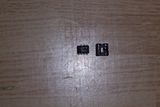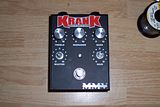I got this pedal from a client. I had no clue what was wrong with it from my first inspection. I plugged in and powered it up. No sound when engaged. When disengaged I got a clean tone, but this is due to the true bypass switching! I haven't seen true bypass on a commercial pedal. True bypass has been done by guitar players and tone freaks to have an unaffected guitar tone when the pedal is disengaged. Once I opened it up I noticed that the main IC, a LM386 audio amp, was crooked in the DIP socket. A DIP socket!!! What?!? The major guitar pedal manufactures don't put DIP sockets in there electronics! Well this company goes all out in design. After removing the IC I see that the socket is completely damaged. It looked like it was melted. I assume that the IC got really hot, blew, and melted the DIP socket plastic. If you look close it's actually pin 6 of the DIP socket that is melted. Pin 6 on the LM386 is the supply voltage pin.


What caused this? Really I would think that larger current from the wrong power supply did the trick. From what I saw the pedal doesn't have a zener regulator to protect it. This would actually be an improvement on Krank's part if they added it. Maybe I should send then an e-mail and share this idea with them. After switching out the DIP socket and a new LM386 the pedal sounds awesome. This repair job is a great example why adding a zener diode on the power supply input of the pedal can save money and the life of your guitar pedals.



No comments:
Post a Comment